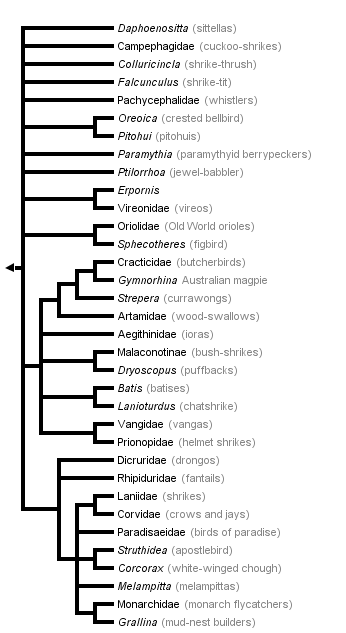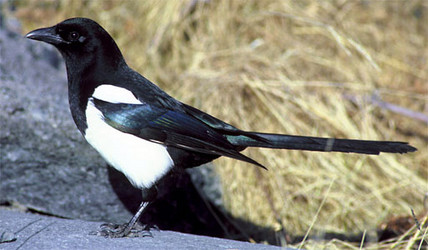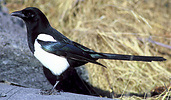Corvoidea



This tree diagram shows the relationships between several groups of organisms.
The root of the current tree connects the organisms featured in this tree to their containing group and the rest of the Tree of Life. The basal branching point in the tree represents the ancestor of the other groups in the tree. This ancestor diversified over time into several descendent subgroups, which are represented as internal nodes and terminal taxa to the right.

You can click on the root to travel down the Tree of Life all the way to the root of all Life, and you can click on the names of descendent subgroups to travel up the Tree of Life all the way to individual species.
For more information on ToL tree formatting, please see Interpreting the Tree or Classification. To learn more about phylogenetic trees, please visit our Phylogenetic Biology pages.
close boxDiscussion of Phylogenetic Relationships
This large clade contains most of the members of Sibley and Ahlquist’s (1990) Corvoidea (Barker et al. 2004, 2004; Beresford et al. 2005). It contains two large, resolved subclades, a few pairs of taxa, and a large, basal polytomy. One large subclade is a collection of mostly shrike-like birds including Cracticidae (butcherbirds), Gymnorhina (Australian magpie), Strepera (currawongs), Artamidae (wood-swallows), Aegithinidae (ioras), Malaconotinae (bush-shrikes), Dryoscopus (puffbacks), Batis (batises), Lanioturdus (chatshrike), Vangidae (vangas), and Prionopidae (helmet shrikes) (Barker et al. 2002, 2004; Beresford et al. 2005; Fuchs et al. 2006). The other group consists of taxa close to Corvidae, including Laniidae (shrikes), Paradiseidae (birds of paradise), Monarchidae (monarch flycatchers), Struthidea (apostlebird), Corcorax (white-winged chough), Grallina (mud-nest builders), Melampitta (melampittas), Dicruridae (drongos), and Rhipiduridae (fantails) (Barker 2002, 2004; Beresford et al. 2005).
References
Barker, F. K., G. F. Barrowclough, and J. G. Groth. 2002. A phylogenetic hypothesis for passerine birds; Taxonomic and biogeographic implications of an analysis of nuclear DNA sequence data. Proc. R. Soc. Lond. B 269:295-308.
Barker, F. K., A. Cibois, P. Schikler, J. Feinstein, and J. Cracraft. 2004. Phylogeny and diversification of the largest avian radiation. Proc. Natl. Acad. Sci. USA 101:11040-11045.
Beresford, P., F. K. Barker, P. G. Ryan, and T. M. Crowe. 2005. African endemics span the tree of songbirds (Passeri): Molecular systematics of several evolutionary "enigmas". Proc. R. Soc. Lond. B 272:849-858.
Fuchs, J., J. Fjeldså, R. C. K. Bowie, G. Voelker, and E. Pasquet. 2006. The African warbler genus Hyliota as a lost lineage in the oscine songbird tree: Molecular support for an African origin of the Passerida. Mol. Phylogen. Evol. 39:186-197.
Harshman, J. 2007. Classification and phylogeny of birds. Pages 1-35 in Reproductive biology and phylogeny of birds (B. G. M. Jamieson, ed.). Science Publishers, Inc., Enfield, NH.
Sibley, C. G., and J. A. Ahlquist. 1990. Phylogeny and classification of birds, Yale U. Press, New Haven.
Title Illustrations

| Scientific Name | Pica pica |
|---|---|
| Location | Kodiak Island, Alaska, USA |
| Comments | Black-billed magpie |
| Creator | Dave Menke |
| Specimen Condition | Live Specimen |
| Source Collection | U.S. Fish and Wildlife Service Online Digital Media Library |
About This Page
Page copyright © 2006
All Rights Reserved.
- First online 31 July 2006
- Content changed 31 July 2006
Citing this page:
Tree of Life Web Project. 2006. Corvoidea. Version 31 July 2006 (under construction). http://tolweb.org/Corvoidea/67955/2006.07.31 in The Tree of Life Web Project, http://tolweb.org/







 Go to quick links
Go to quick search
Go to navigation for this section of the ToL site
Go to detailed links for the ToL site
Go to quick links
Go to quick search
Go to navigation for this section of the ToL site
Go to detailed links for the ToL site